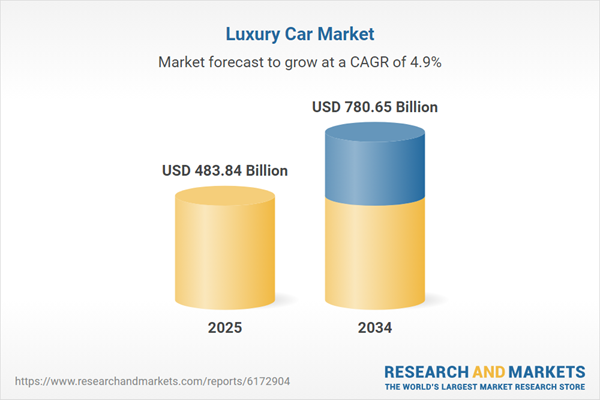Increasing Demand for Electric Luxury Cars to Augment the Luxury Car Industry Growth
The luxury car market is growing faster due to the increasing technological advancements like the Internet of Things (IoT) and real-time information solutions being integrated into all-EV charging station systems for electric luxury cars. Leading manufacturers are also developing the latest smart mobility technologies, such retina recognition, autonomous driving, and personal voice assistance. The luxury car market growth is accelerated by the rise in demand for premium and upscale vehicles in addition to an increase in cars powered by diesel engines. Additionally, a rise in passenger car sales brought on by consumer desire for superior vehicles are one of the key luxury car market trends. The luxury car market also benefits from the expansion of the automotive industry, a boom in investments, and rising disposable income.Increasing Demand for Electric Luxury Cars to Augment the Luxury Car Market Growth
As per the luxury car market analysis, the electric segment is expected to grow at a significant rate in the forecast period. The segment's growth is expected to be driven by the factor that governments all over the world are strengthening automobile emission limits, as concern for the environment and environmental preservation grows.As a result, there is an increasing need for environmentally friendly and sustainable transportation, such as electric automobiles. Various governments are also providing increased subsidies and incentives to these car owners, which is expected to further propel the luxury cars market forward.
Asia-Pacific to Provide Significant Opportunities for the Luxury Car Market Growth
During the forecast period, the Asia-Pacific is expected to be one of the most prominent of all regions, with one of the largest luxury car market in the world. The presence of a number of large-scale firms in this area has had a significant impact on the regional market growth. The luxury car manufacturers in the Asia-Pacific have benefited from the ever-increasing population in nations such as India and China. Within the Asia-Pacific, the China luxury car market has high growth potential. The low costs and tax advantages connected with assembly and sale procedures across numerous regions account for the growing number of production units in these locations.Luxury Car Market Segmentation
Luxury cars are passenger vehicles that are designed to deliver advanced features, excellent quality, greater levels of equipment, and enhanced comfort to their occupants. Luxury cars are available in a variety of vehicle types, including hatchbacks, SUVs, sedans, and even minivans. Luxury cars also include equipment such as automatic safety measures, entertainment systems, and built-in seat massagers. However, these are costlier than ordinary automobiles and have high-end materials and finishes on both the interior and exterior of the vehicle.By vehicle type, the market is divided into:
- Hatchback
- Sedan
- Sports Utility Vehicle
- Multi-purpose Vehicle
Based on drive type, the market can be segmented into:
- IC Engine
- Electric
On the basis of price category, the market is divided into:
- USD 80,000 to USD 149,000
- USD 150,000 to USD 299,000
- USD 300,000 to USD 500,000
- Above USD 500,000
The regional markets for the product include:
- North America
- Europe
- Asia-Pacific
- Latin America
- Middle East and Africa
Growing Collaborations Among Companies to Bolster the Growth of the Luxury Car Market
A strong market rivalry around the world due to the increasing globalisation and the rising demand for cars has been aiding the luxury vehicles market growth. This, in turn, has encouraged several companies to implement novel methods to improve customer driving experience, increasing the luxury car market share by brand. These techniques have helped them create a foothold in the market. Thus, the growing number of cross-industry collaborations has been positively impacting the luxury car market share worldwide.Furthermore, the market for pre-owned luxury vehicles is steadily increasing because owners usually sell these vehicles after one or two years of use in order to upgrade to better models and modifications, increasing the luxury car brand market share. The used luxury vehicle market is becoming increasingly systematised to satisfy rising demand, with easy access to financing, lower entry pricing, and annual maintenance contracts. These factors are expected to further increase the global luxury car market size in the coming years.
Key Players in the Global Luxury Car Market
The report gives a detailed analysis of the following key players in the global luxury car market, covering their competitive landscape, capacity, and latest developments like mergers, acquisitions, and investments, expansions of capacity, and plant turnarounds:- Ferrari S.p.A
- Bugatti Automobiles
- Rolls-Royce Motor Cars
- Daimler AG
- Automobili Lamborghini S.p.A.
- Koenigsegg Automotive AB
- Aston Martin Lagonda Limited
- Bentley Motors Limited
- Horacio Pagani S.p.A
- Dr. Ing. h.c. F. Porsche AG
- Toyota Motor Corporation
- Tesla, Inc.
- General Motors
- Others
Table of Contents
Companies Mentioned
The key companies featured in this Luxury Car market report include:- Ferrari S.p.A
- Bugatti Automobiles
- Rolls-Royce Motor Cars
- Daimler AG
- Automobili Lamborghini S.p.A.
- Koenigsegg Automotive AB
- Aston Martin Lagonda Limited
- Bentley Motors Limited
- Horacio Pagani S.p.A
- Dr. Ing. h.c. F. Porsche AG
- Toyota Motor Corporation
- Tesla, Inc.
- General Motors
Table Information
| Report Attribute | Details |
|---|---|
| No. of Pages | 155 |
| Published | August 2025 |
| Forecast Period | 2025 - 2034 |
| Estimated Market Value ( USD | $ 483.84 Billion |
| Forecasted Market Value ( USD | $ 780.65 Billion |
| Compound Annual Growth Rate | 4.9% |
| Regions Covered | Global |
| No. of Companies Mentioned | 14 |









